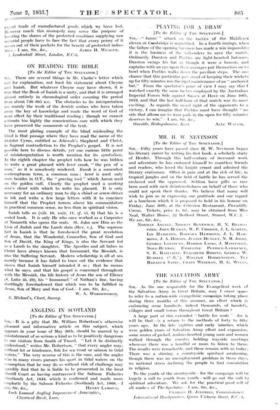ON READING THE BIBLE • [To the Editor of THE
SencrA•roa.] Sin, --There are several things in Mr. Clarke's letter which call for explanation, not least his statement about Cheyne and Isaiah. But whatever Cheyne may have shown, it is true that the Book of Isaiah is a unity, and that it is arranged almost entirely in chronological order covering the period from about 740-695 B.C. The obstacles to its interpretation are mainly the work of the Jewish scribes who have taken away the key of knowledge and made the word Of God of none- effeet by their traditional reading ; though we cannot estimate too highly the conscientious care with which they have preserved the consonants of the text.
The Most glaring example of the blind misleading the blind is that passage where they have read the natne of the idolater Cyrus, entitled as Jehovah's Shepherd and Christ, in flagrant contradiction to the Prophet's, gospel. It is not possible here to discuss details, yet one 'curious little point of misinterpretation is worth mention for its symbolism. In the eighth chapter the prophet tells how he was bidden to write a great placard with heret enosh, "the pen of a man," as it is senselessly rendered. Enosh is a somewhat contemptuous term, a common man ; heret is used only once besides in 0.T., the "graving tool" which Aaron used on the golden calf. Clearly the prophet used a working umn's chisel with which to Write his placard. It is only necessary for an ordinary man to dip a chisel or screwdriver in ink and write a few large letters with* it to convince himself that the PrOphet towers above his commentators in practical common sense, no less than in spiritual vision.
Isaiah tells us (viii. 16, xxix. 11, cf. vi. 9) that his is a sealed book. It is only He who once worked as a Carpenter at Nazareth who opens the seals. St. John saw Him as the Lion of Judah and the Lamb slain (Rev. v.). The supreme fact in Isaiah is that he foreshowed the great revelation of Jesus, that the Wonderful, Counsellor, Son of God and Son of David, the King of Kings, is also the Servant led as a Lamb to the slaughter. The Apostles and all babes in Christ have always- known that Immanuel, the Messiah, is also the Suffering Servant. Modern scholarship is all at sea merely' because it has failed to trace out the evidence• that shows that Isaiah himself intended it so ; that he means what he Says, and that his gospel is concerned throughout with-the Messiah, the life history of Jesus the son of Eliezer (S. Luke iii. 29), his " Immanuel " of Nathan's line, having startlingly foreshadowed that which was to be fulfilled in Jesus, Son of Mary and Son of God.—I am, Sir, &e.,-




































 Previous page
Previous page